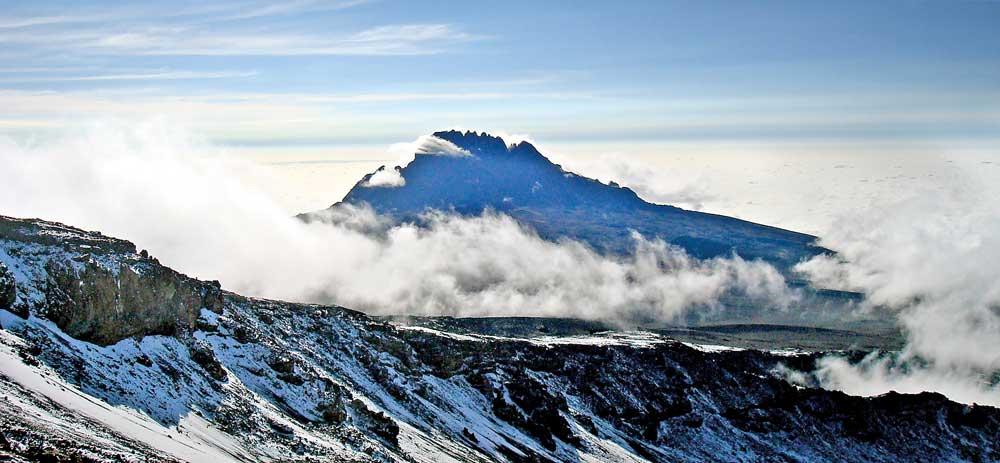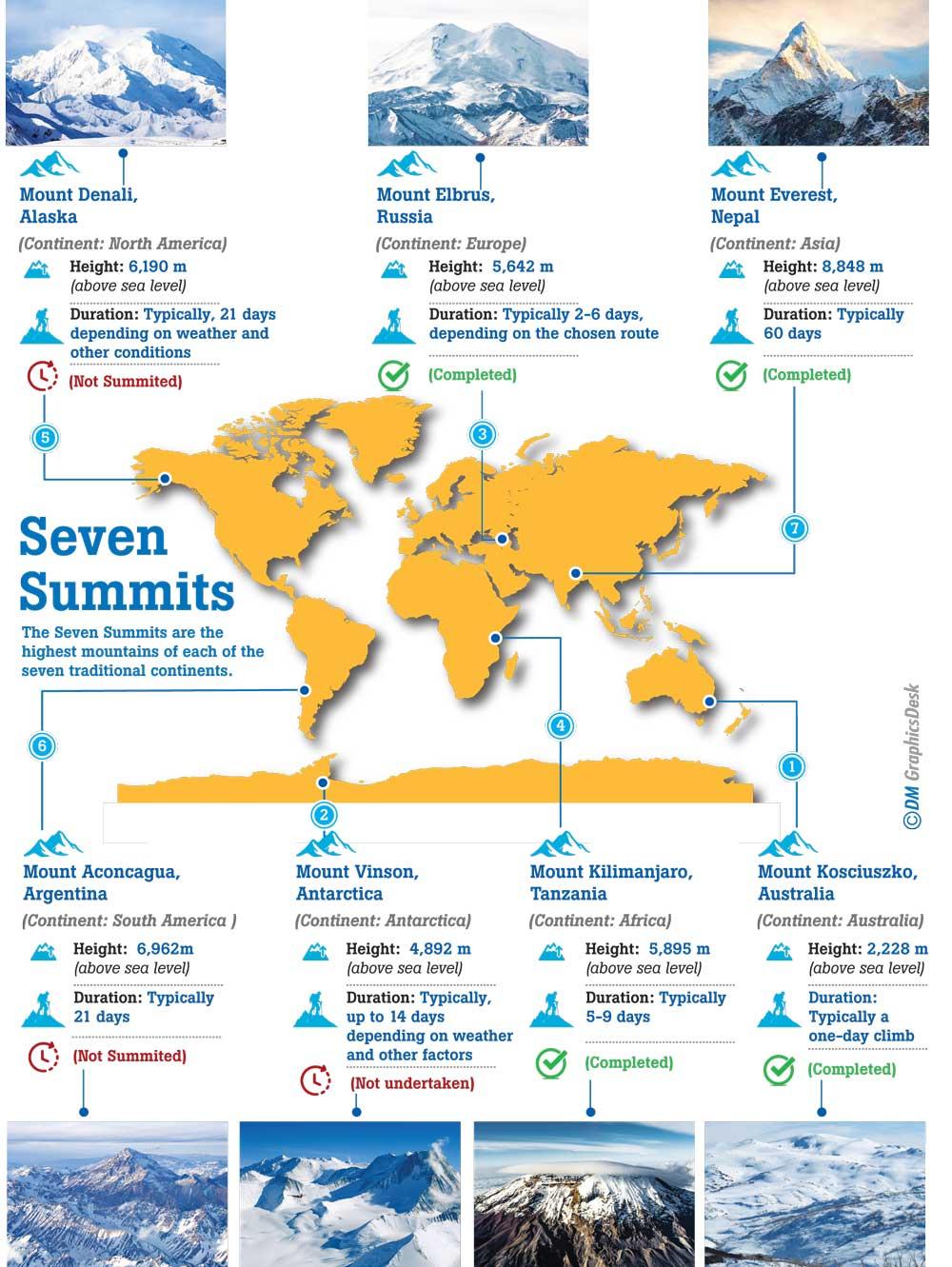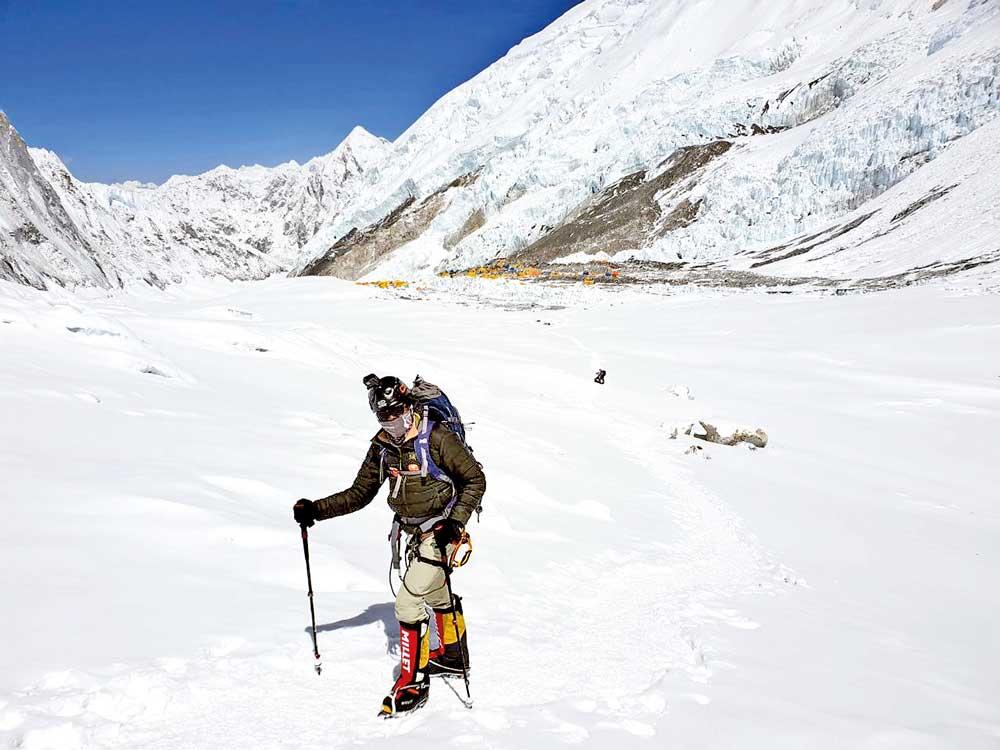22 Aug 2024 - {{hitsCtrl.values.hits}}

Mount Kilimanjaro, Tanzania, Africa
It is believed that only about 350 mountaineers have accomplished this intense and arduous feat since Richard Bass did it first in 1985
The Seven Summits challenge entails climbing the highest mountains on all seven continents
Mount Denali, the tallest mountain in North America, is regarded as one of the most challenging with a success rate of around 50%
Peries attempted to summit Aconcagua in 2019 alongside Jayanthi Kuru-Utumpala but, had to turn back due to adverse weather
 Last week, Daily Mirror interviewed Johann Peries, the mountaineer who’s on a quest to become Sri Lanka’s first to achieve the ‘Seven Summits’ challenge–considered the world’s most coveted mountaineering achievement.
Last week, Daily Mirror interviewed Johann Peries, the mountaineer who’s on a quest to become Sri Lanka’s first to achieve the ‘Seven Summits’ challenge–considered the world’s most coveted mountaineering achievement.
The Seven Summits challenge entails climbing the highest mountains on all seven continents. The challenge was first accomplished by American businessman Richard Bass in 1985, and since then it is believed that only about 350 mountaineers have accomplished this intense and arduous feat. While some peaks are a jolly day’s hike, others are grueling climbs that take weeks to summit and also pose the challenge of having to encounter several brushes with death.

While Peries has completed six of the seven mountains, he was able to successfully summit only four of the seven mountains; owing to bad weather and lack of supplies. He is expected to begin 2025 with the rest of the challenge and hopes to complete the seven summits by mid next year!
Let’s have a look at the summits Johann has already completed, and the ones he will be taking on early next year.
1. Mount Kosciuszko, Australia (Completed)
Duration: Typically a one-day climb
Mount Kosciuszko, standing at 2,228 metres above sea level, is the tallest mountain on mainland Australia. It is situated in the Snowy Mountains’ Main Range, within Kosciuszko National Park, part of the Australian Alps in New South Wales.
Climbing Mount Kosciuszko is considered relatively easy and many who attempt it reach the summit. Unlike the other summits in the challenge, this mountain is known for being a popular day hike.
Peries describes Mount Kosciuszko as a ‘day picnic’ and likens it to Pidurutalagala in height. He recalls the climb as a beautiful trek through picturesque countryside. “The highlight for me was doing it in 2020 with six of my colleagues who had climbed Mt. Everest with me from around the world. We gathered for one of their weddings and decided to climb Mount Kosciuszko together. Although it wasn’t a significant climb, being with that group made it special,” he shared during his interview with the Daily Mirror.

At Mount Everest, Nepal
2. Mount Vinson, Antarctica (Not undertaken)
Duration: Typically, up to 14 days depending on weather and other factors
Mount Vinson, towering at 4,892 metres, is the highest peak in Antarctica. It is part of the Vinson Massif, which includes the next five highest summits on the continent. The massif is located about 1,200 kilometres from the South Pole, making it one of the most remote and challenging climbs in the world.
Peries will be taking on Mount Vinson in early January next year, and considers this one of the more challenging summits. Wading through knee-high snow- while carrying your supplies such as food, tents, and toilets amounting to about 50kg, with no guides or porters- makes the climb all the more challenging, according to him.
|
Mount Everest is as mentally challenging as it is physically because you face the reality of death. Seeing dead bodies along the way hits you hard and makes you think that this could also be you. I saw people dying and had even spoken to someone who died later; all of it was mentally challenging. However, you overcome it over time” - Johann Peries (Mountaineer) |
3. Mount Elbrus, Russia, Europe (Completed)
Duration: Typically 2-6 days, depending on the chosen route
Mount Elbrus, straddling the border between Europe and Asia, is located in southwest Russia within the Caucasus Mountains. It is the highest point in both Russia and Europe, standing as a dormant volcano approximately 2.5 million years old, with its last known eruption occurring around 50 C.E. The mountain boasts of two summits: the higher western peak at 5,642 meters and the slightly lower eastern peak at 5,621 metres.
Mount Elbrus is a popular destination for skiing, with infrastructure such as cable cars that can significantly reduce the time required to reach the summit, making it one of the more accessible climbs of the Seven Summits.
Peries successfully summited Mount Elbrus in 2023 and describes it as one of the most breathtaking mountains he has encountered. “You just stand there, taking in this whole vista, which is simply spectacular,” he remarked.
4. Mount Kilimanjaro, Tanzania, Africa (Completed)
Duration: Typically 5-9 days
|
At Mount Kosciuszko, Australia
|
Mount Kilimanjaro, standing at 5,895 metres, is not only the highest mountain in Africa, but also the tallest free-standing mountain in the world. Located in Tanzania, this dormant volcano comprises three volcanic cones: Kibo, Mawenzi, and Shira. Kibo, the highest peak, is the summit of the mountain and remains dormant, with the potential to erupt again, while Mawenzi and Shira are extinct.
Positioned near the equator, Mount Kilimanjaro offers a striking variety of climates, from tropical jungle at its base to alpine deserts near the peak, and glaciers at the summit. However, these glaciers are rapidly disappearing, with 90% of the ice having vanished since 1900.
While Mount Kilimanjaro is considered more of a trek, mountaineers are cautioned against taking it lightly especially due to the drastic increase in altitude during the last ascent to the peak.
Speaking of his experience summitting Mount Kilimanjaro, he said, “It is often seen as an easier climb, but I advise against underestimating it. Altitude affects you because it’s done in a short timeframe—eight days. It’s quite challenging, but many people do it. There are different routes, and it’s a beautiful mountain.”
5. Mount Denali, Alaska, North America (Not Summited)
Duration: Typically, 21 days depending on weather and other conditions
Denali, also known as Mount McKinley, is the tallest mountain in North America, rising to 6,190 metres above sea level in south-central Alaska. It ranks as the third-highest peak among the Seven Summits and is regarded as one of the most challenging climbs, with a success rate of around 50%.
Peries, who attempted Denali last year, was compelled to turn around on day 21 due to an approaching storm. The lack of support from guides and porters makes summiting Mount Denali tough, he says. Hence, much effort needs to be put into training for the climb.
Johann plans to take on Mount Denali once again in May 2025, thereby concluding his Seven Summit challenge.
6. Mount Aconcagua, Argentina, South America (Not Summited)
Duration: Typically 21 days
Cerro Aconcagua, commonly known as Aconcagua, is located in Argentina near the border with Chile. It is the highest peak in the Western Hemisphere, standing at 6,962 metres above sea level. Aconcagua is part of the Andes Mountain range and is believed to have formed through volcanic activity, though it isn’t an active volcano.
Aconcagua is a popular destination for hikers and mountaineers, but its extreme altitude poses significant risks. A number of climbers have succumbed to altitude sickness while attempting to reach the summit. Additionally, the mountain is notorious for high winds and frequent storms, which further complicate the climb. The success rate for reaching the summit is approximately 30%.
Peries attempted to summit Aconcagua in 2019 alongside Jayanthi Kuru-Utumpala but, like with Mount Denali, had to turn back due to adverse weather conditions. “It’s quite challenging, but absolutely stunning,” Johann remarked. He plans to summit Mount Aconcagua after completing Mount Vinson.
|
Peries at Mount Denali, Alaska
|
7. Mount Everest, Nepal, Asia (Completed)
Duration: Typically 60 days
Mount Everest, standing at 8,848.86 metres, is Earth’s highest mountain above sea level. Located in the Himalayan mountain range, Everest is situated between Nepal and Tibet, an autonomous region of China.
The mountain attracts many climbers, including highly experienced mountaineers, though only a small percentage successfully reach the summit. There are two main climbing routes: the southeast route from Nepal, known as the “standard route,” and the northern route from Tibet. While the standard route doesn’t present significant technical climbing challenges, Everest is fraught with dangers such as altitude sickness, unpredictable weather, and high winds, along with hazards from avalanches and the treacherous Khumbu Icefall. As of May 2024, nearly 350 people have died on Everest, and over 200 bodies remain on the mountain due to the perilous conditions that make recovery nearly unthinkable.
Kuru-Utumpala became the first Sri Lankan to summit Mount Everest in 2016. Peries followed as the second Sri Lankan to reach the summit in 2018, after having to turn back just 400 metres from the top during a previous attempt due to low oxygen supplies.
Johann considers Mount Everest the most challenging climb; both mentally and physically. “Mount Everest is as mentally challenging as it is physically because you face the reality of death. Seeing dead bodies along the way hits you hard and makes you think that this could also be you. I saw people dying and had even spoken to someone who died later; all of it was mentally challenging. However, you overcome it over time,” he shared.
24 Dec 2024 30 minute ago
24 Dec 2024 52 minute ago
24 Dec 2024 2 hours ago
24 Dec 2024 3 hours ago
24 Dec 2024 3 hours ago